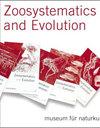Natural history collections help resurrecting Glomeris herzogowinensis Verhoeff, 1898 and further clarify the nomenclature of two Onychoglomeris subspecies of Attems (Diplopoda, Glomerida, Glomeridae)
IF 1.6
2区 生物学
Q2 ZOOLOGY
引用次数: 0
Abstract
Based on the study of freshly-collected material and old museum specimens, we have solved a decades-old riddle surrounding the name Onychoglomeris herzogowinensis (Verhoeff, 1898). The southern Dinaric coastal species Glomeris herzogowinensis Verhoeff, 1898 is revived, while Onychoglomeris herzogowinensis australis Attems, 1935 and O. h. media Attems, 1935, are treated here as full species after returning the specific name to Glomeris Latreille, 1902, O. australis Attems, 1935, stat. nov. and O. media Attems, 1935, stat. nov. Besides the designation of lectotypes, we provide comprehensive illustrations, diagnoses, detailed remarks and a distribution map for all three species. In addition, DNA barcoding provided COI sequences for Glomeris herzogowinensis and Onychoglomeris australisstat. nov., along with the first barcoding data of one additional species of Onychoglomeris Verhoeff, 1906, O. ferraniensis Verhoeff, 1909 and two Glomeris species, the Balkan G. balcanica Verhoeff, 1906 and the trans-Adriatic G. pulchra Koch, 1847. The significance of historical specimens from natural history museums is briefly discussed.自然历史藏品有助于复活Glomeris herzogowinensis Verhoeff, 1898,并进一步澄清了Attems的两个Onychoglomeris亚种的命名法(倍足纲,糯米目,糯米科)
根据对新采集材料和博物馆旧标本的研究,我们解开了围绕 Onychoglomeris herzogowinensis(Verhoeff,1898 年)这一名称的数十年之谜。h. media Attems, 1935, stat. nov. and O. media Attems, 1935, stat. nov.除了指定模式标本外,我们还为这三个物种提供了全面的插图、诊断、详细注释和分布图。此外,DNA 条形码提供了 Glomeris herzogowinensis 和 Onychoglomeris australisstat. nov.的 COI 序列,以及 Onychoglomeris Verhoeff, 1906 的一个新种 O. ferraniensis Verhoeff, 1909 和两个 Glomeris 种(巴尔干 G. balcanica Verhoeff, 1906 和跨亚得里亚海 G. pulchra Koch, 1847)的首个条形码数据。本文简要讨论了自然历史博物馆历史标本的意义。
本文章由计算机程序翻译,如有差异,请以英文原文为准。
求助全文
约1分钟内获得全文
求助全文
来源期刊

Zoosystematics and Evolution
ZOOLOGY-
CiteScore
3.50
自引率
5.00%
发文量
34
审稿时长
16 weeks
期刊介绍:
Zoosystematics and Evolution, formerly Mitteilungen aus dem Museum für Naturkunde in Berlin, is an international, open access, peer-reviewed life science journal devoted to whole-organism biology. It publishes original research and review articles in the field of Metazoan taxonomy, biosystematics, evolution, morphology, development and biogeography at all taxonomic levels. The journal''s scope encompasses primary information from collection-related research, taxonomic descriptions and discoveries, revisions, annotated type catalogues, aspects of the history of science, and contributions on new methods and principles of systematics. Articles whose main topic is ecology, functional anatomy, physiology, or ethology are only acceptable when of systematic or evolutionary relevance and perspective.
 求助内容:
求助内容: 应助结果提醒方式:
应助结果提醒方式:


